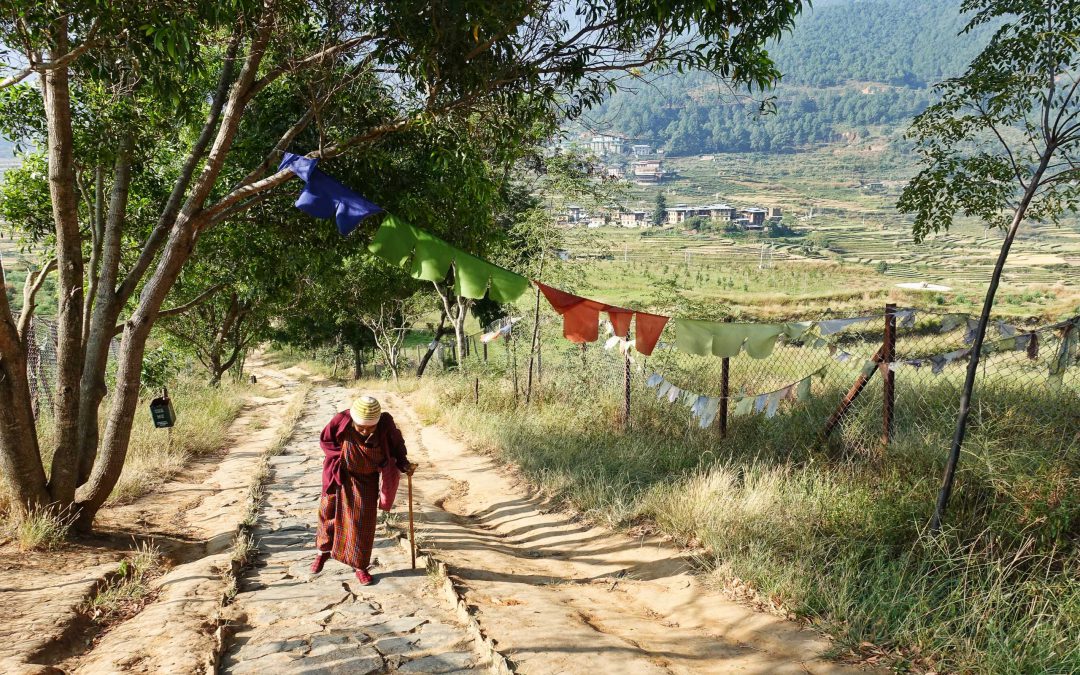The folklore of Bhutan is rich with colorful and extraordinary tales. The most unique and extraordinary by far though is the legend of the Buddhist monk Drukpa Kunley. Commonly referred to as the Divine Madman, the Mad Monk or the Mad Saint. He is notorious for his Thunderbolt of Flaming Wisdom and considered a saint of fertility. His temple, Chimi Lhakhang, is located in the Punakha district and is surrounded by villages famous for their buildings proudly decorated with phallus paintings.
Drukpa Kunley was not your average Buddhist monk. He believed the constraints of the middle-way to be too restrictive for everyday people seeking enlightenment. Vices, such as sex and alcohol, were embraced by Drukpa Kunley. It is said that anyone seeking a blessing or guidance from him must not come empty-handed. The standard offering was a beautiful woman and bottle of wine. His love of women and sex eventually garnered him the name ‘The Saint of 5,000 Women.’ It was believed that sex with Drukpa Kunley would impart a blessing, lead to enlightenment, and cure possibly infertility.
There are also many tales of Drukpa Kunley subduing demons and demonesses that terrorized the villages of Bhutan. In one such tale the demoness, Loro Duem, was residing near the Dochu La mountain pass preventing the locals from crossing through. Some of the villagers came to Drukpa Kunley and implored his help to cast out the demon. Sympathizing with their complaints, he set off to find the demoness. Having heard that Drukpa Kunley was coming the demoness transformed into a dog, so as not to be discovered, and fled. It did not work though. Drukpa Kunley soon found the demoness, cornered her and subdued her with his Thunderbolt of Flaming Wisdom (aka his penis). He trapped the demoness within a rock which and, as legend has it, is the site where the temple to Drukpa Kunley, Chimi Lhakhang, stands today. It is this and many other similar tales that make this area of Bhutan so interesting to visit and see first hand.
Our visit to Chimi Lhakhang began at one of the surrounding villages. We knew we were in the right place by all the enormous phallus paintings seen on every building. There were whole shops dedicated to ‘phallus handicrafts.’ It was amusing at first, but we reminded ourselves this was their culture and it deserved our respect regardless of how unusual it was at first. We later found ourselves thinking about how we could get away with a flaming phallus painted on our house.



We made our way through the village and out into the rice fields. Ahead in the distance, our guide, Jemme, pointed out a lone hill with a temple at the top. That was where we were headed! To get there though we had to zig-zag through a maze of rice paddy’s each separated by irrigation ditches and earthen berms. Along the way, we got to see some Bhutanese architecture and construction in action. Some locals were working on a new home and were happy to let us have a look.



After a few more zigs and zags through the rice paddies, we arrived at the main trail up to Chimi Lhakhang. That morning we appeared to be the only other foreigners making the pilgrimage to the temple. We joined the path with a few elderly Bhutanese people with prayer malas in hand slowing making their way up. At the top, there was a large bodhi tree, a Tibetan style stupa, and the temple. This temple was much smaller than most of the others we had seen in Bhutan. Jemme led us into the courtyard where we removed our shoes and turned our cameras off before entering the temple.
Inside the temple was lavishly decorated with likenesses of Drukpa Kunley, Guru Rinpoche, and other Bhutanese deities. We took a seat on the floor and spent a few moments in quiet meditation. Now, although Jessica and I weren’t entirely on a mission to get pregnant anytime soon, we still felt it necessary to receive a blessing from the large wood and ivory phallus of fertility. Jessica approached the monk and bowed her head. With the phallus in hand, the monk lightly thumped it upon her head a few times while giving a blessing. Afterward, he wrapped a white silk scarf around her neck and parted with a head nod. (Oh how I wish I could have taken a picture.)
Having received the fertility blessing, we left the temple, and a found a seat in the shade of the bodhi tree outside. There Jemme told us the story of demoness Loro Duem and pointed out the stupa which is believed to mark the place where the demoness was trapped in stone by Drukpa Kunley. This act led to the liberation of the villagers she terrorized. It’s no wonder why they would build a temple in his honor. Drukpa Kunley is quite possibly the most prominent person in Bhutanese folklore, and his unconventional practices have earned him a place in their history forever.


With our visit complete and the sun now bearing down directly overhead, we made our way down the hill. We zig-zagged our way back through the rice paddies and into the village once again. There, our driver, Mr. Ungen, was waiting. For most of the trip, he spoke very little and showed even less expression. However, as he opened the car door for Jessica, he asked, “you take blessing?” Jessica responded with a nod of affirmation, and he lit up with a smile giving me two thumbs up. I couldn’t help but smile back, and we both laughed as we drove off.
Bhutan is fraught with opportunities to see folklore and legend very much alive and part of everyday life. In a world so connected, the abundance of information tends to extinguish myths and fantastic tales. It was refreshing to experience a place where legends still live.





Wow I like it